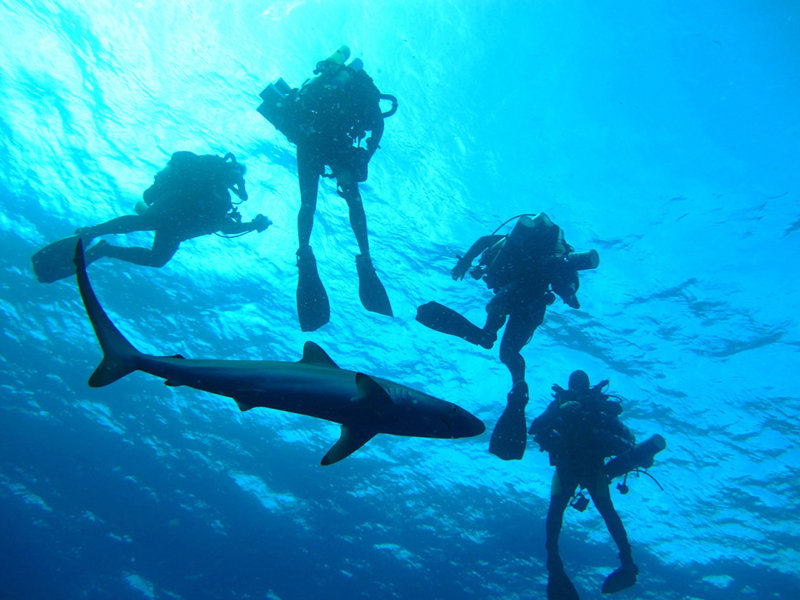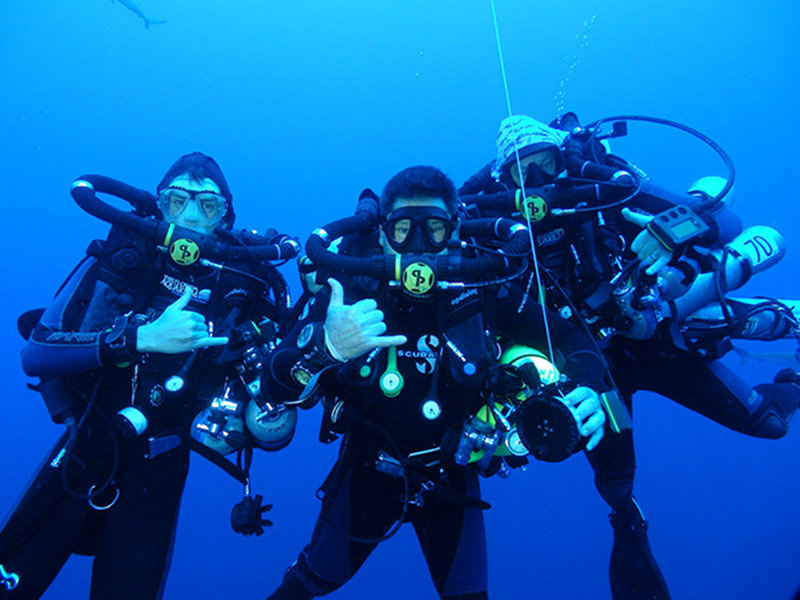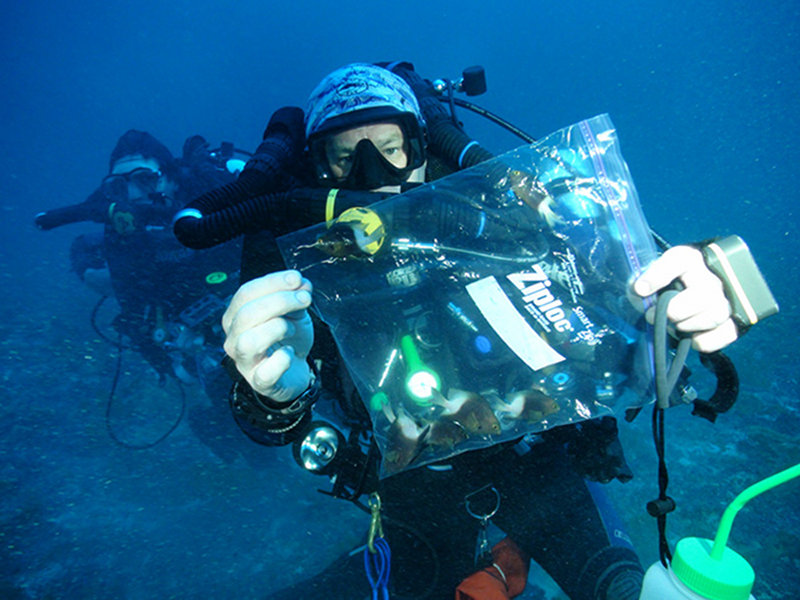
By Rick Riera-Gomez, Scientific Diving Officer - Rosenstiel School of Marine & Atmospheric Science, University of Miami
August 18, 2013

The technical dive team often receives visitors during decompression stops. This time a silky shark comes in close to pose with the group. Photo credit: Robbie Christian, University of Miami. Image courtesy of Robbie Christian, University of Miami. Download larger version (jpg, 287 KB).
In preparation for departing again for Pulley Ridge, I am reviewing our trip equipment lists, my dive logs, pictures and videos of last year’s trip.
The dives we did during last year’s cruise were in the 65-80 m (195 – 240 fsw) range. I am planning for the same this year. All the dive sites I have seen suggest we’ll be in the same areas for collecting samples. For contingency purposes, the gases we’re using will allow us to make dives as deep as 95 m (300 fsw). The gas we use for the deepest part of the dives is 12/65 trimix (12% oxygen, 65% helium, and 23% nitrogen). We mix this gas ourselves prior to the cruise and have to verify the accuracy of the gas percentages.

The technical dive team during an in-water decompression stop. Technical diving is an equipment and training intensive activity. Image courtesy of Mike Echevarria, The Florida Aquarium. Download larger version (jpg, 289 KB).
Preparation for dives to these depths is extensive. Divers have to check out their rebreathers to make sure they’re ready for the trip. This includes conducting dives to identify any problems, checking the dates on oxygen sensor cells and batteries, checking regulator pressures, checking the electronics to verify they are working properly, checking hoses and anything else that we feel may present a potential problem. Divers then have to check their bailout bottles, which are additional SCUBA tanks used in the event of a rebreather problem or failure.
The dive profiles we are planning during this cruise will be similar to what we conducted last year. Most of the dives we did were in the 75m (225 fsw) depth range for about 20 minutes. This gave us a total run time on the dive, surface to surface, of about 100-110 minutes. On this cruise we’re looking at a variety of diving profiles to try to maximize our sample collections, so our dive times may be changing.
For the dives at Pulley Ridge, each diver will carry three additional tanks. In the bailout bottles, there will be different gasses to help us maximize the safety and efficiency of decompression. Varying amounts of oxygen, nitrogen and helium are ‘trimixed’ for deeper decompression. For the shallowest decompression, 20 ft to the surface, 100% oxygen is used.
All the miscellaneous equipment needs to be prepped and readied for the dives. Divers use HID (High Intensity Discharge) or LED lights, surface marker buoys, and reels on each dive for safety and communication with other divers or the surface.

Casey Coy shows off samples of damsel fish collected during a technical dive. Image courtesy of Mike Echevarria, The Florida Aquarium. Download larger version (jpg, 295 KB).
At Pulley Ridge we occasionally get very strong currents. To be able to dive, hold our position and collect our samples, we use high-speed scooters. These scooters, also called DPVs (Diver Propulsion Vehicles), allow divers to offset the push of the currents. They also help us get from one area to another if we’re not finding the numbers of samples we need on a dive. The prep for the DPVs is making sure the batteries are charged, that the o-rings and seals are good and the controls are all working smoothly.
Our rebreather team is made up of Casey Coy, Mike Terrell, and Mike Echevarria of the Florida Aquarium; Milton Carlo and Evan Tuohy of the University of Puerto Rico, Mayagüez; and Robbie Christian, Assistant Diving Safety Officer, and me from the University of Miami. Esther Goldstein of the University of Miami will be on board to preserve the specimens we collect for genetic analysis back in the lab.
We’re also checking all the science sampling gear we’ll be using on our dives. The samples we’ll collect will be split into four categories – fish, coral, sponge and algae. The bottom is very sparse and requires us to be very opportunistic and prepared to collect whatever we find once we arrive. The dive plan has divers split into teams with specific objectives for each team. One team will be collecting fish, one corals and the other sponge and algae.
All in all we’ve checked and double checked the gear and it’s ready to go. The divers are eager to get in the water. And we’re all excited about a productive and fun cruise.